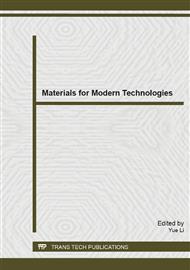p.39
p.45
p.51
p.55
p.60
p.66
p.72
p.81
p.89
Synthesis and Luminescence Properties of Ba3Y1-xEuxB3O9 (0.05≤x≤0.35) under UV Excitation
Abstract:
Single phase of Ba3Y1 - xEuxB3O9 (0.05 ≤ x ≤ 0.35) samples was prepared by the solid state reaction. The crystal structure, the surface, the particle size and luminescence properties were characterized by X-ray diffractometer, scanning electron microscopy and spectrophotometer. The results showed that the obtained samples with the particle size from 0.3 to 1.5 um were hexagonal structure. Monitored by 592 nm emission, the excitation spectra of Ba3Y1 - xEuxB3O9 were dominated by the charge transfer band of O2-→Eu3+ peaking at about 259 nm until x = 0.15; the transition from 7F0 to 5L6 level of Eu3+ at about 395 nm was maximum after x > 0.15. The strongest emission peak due to the 5D0→7F1 transition of Eu3+ was all located at about 592 nm in the emission spectra of Ba3Y1 - xEuxB3O9, and the maximum emission was obtained at x = 0.15 and 0.3 under 254 and 395 nm excitation, respectively. The excitation process under the two excitation energies was analyzed. It indicated that only the centrosymmetric lattices could be excited under 254 nm excitation; both the centrosymmetric and noncentrosymmetric positions could be excited by 395 nm, accordingly, the ratio of the red emission (5D0→7F2) to the orange one (5D0→7F1) increased, leading to a better chromaticity of the phosphors.
Info:
Periodical:
Pages:
60-65
Citation:
Online since:
April 2014
Authors:
Keywords:
Price:
Сopyright:
© 2014 Trans Tech Publications Ltd. All Rights Reserved
Share:
Citation:


